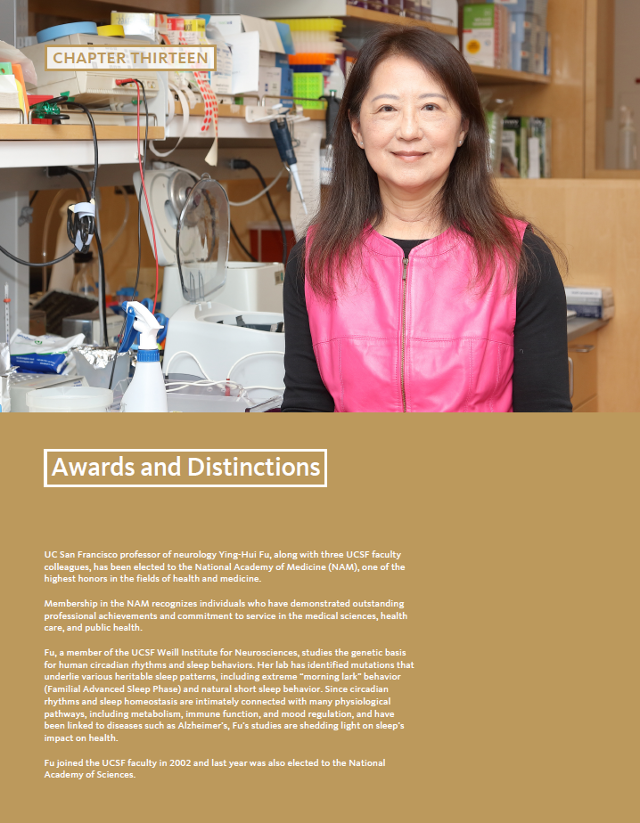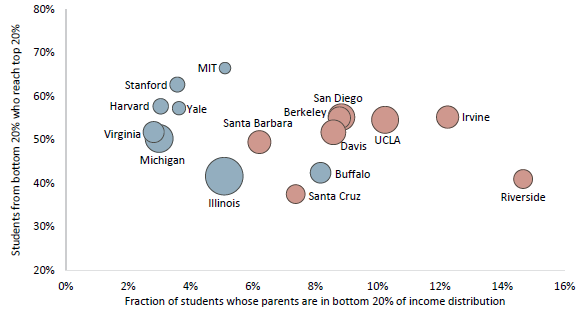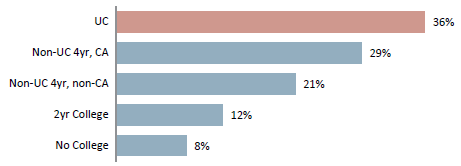Chapter 13:
Honors and Rankings

Overview
Honors and rankings are one way to demonstrate the University’s performance and prestige. They reflect reputations and help to position the University nationally and internationally. This chapter first presents metrics of faculty awards and memberships. These represent some of the highest aspirations of research faculty, signaling noteworthy participation and contribution to research and scholarship in a particular area of expertise.
While the University’s faculty demonstrate unparalleled excellence, also notable is the opportunity for students of diverse backgrounds to learn and study with these distinguished researchers and educators. One of the points of pride for the University of California is providing students from the bottom end of the economic spectrum with access to an educational and research environment comparable to the nation’s finest private institutions but on a significantly larger scale.
This chapter features data from the New York Times’ annual College Access Index, showing that the University of California leads the nation in the “Top Colleges Doing the Most for the American Dream.” It also features data from the Equality of Opportunity Project and the associated CLIMB (Collegiate Leaders in Increasing MoBility) initiative, which leverage national earnings and taxation data to study how colleges affect social mobility.
Universities are ranked in numerous ways, with publishers of rankings choosing criteria based on different audiences and different aims. This chapter highlights just two well-known rankings. U.S. News and World Report (USNWR) focuses on academic reputation, graduation rates, student selectivity, and financial resources to create its list of America’s Best Colleges. The Shanghai Academic Ranking of World Universities ranks institutions around the globe, primarily using faculty research productivity. Additional rankings for UC campuses are available at the link in the section below. While recognizing that these rankings may be useful sources of information, UC does not endorse any particular ranking system nor does it have specific goals with respect to any of them.
For more information
UC faculty receive many prestigious awards because they are thought leaders in their fields.
13.1.1 Nobel Prizes by campus affiliation
Nobel Winners Table
|
Chemistry |
Economics |
Literature |
Medicine |
Physics |
Peace |
| Berkeley/Berkeley Lab |
9 |
5 |
1 |
1 |
8 |
|
| Irvine |
2 |
|
|
|
1 |
|
| Livermore Lab |
|
|
|
|
1 |
|
| UCLA |
3 |
1 |
|
1 |
1 |
|
| Riverside |
1 |
|
|
|
1 |
|
| San Diego |
5 |
3 |
|
6 |
2 |
1 |
| San Francisco |
|
|
|
5 |
|
|
| Santa Barbara |
2 |
1 |
|
|
4 |
|
Sixty-four faculty and researchers affiliated with the University of California have won 65 Nobel Prizes, representing nearly seven percent of the 935 laureates.
A list of UC’s laureates can be found at nobel.universityofcalifornia.edu.
13.1.2 Prizes, medals and awards won by UC faculty

In addition to the 296 prizes, medals and awards presented in the chart above, many UC faculty are members of prestigious National Academies, providing leadership in service and general welfare to the nation.
National Academy of Sciences: 616
National Academy of Engineering: 265
National Academy of Medicine: 222
National Academy of Inventors: 72
The New York Times identified UC campuses as the best in the nation at enrolling, supporting, and graduating large numbers of lower-income students.
13.2.1 New York Times College Access Index, 2017
The New York Times’ College Access Index ranks institutions with at least a 75 percent five-year graduation rate by the share for freshman entrants that are Pell Grant recipients, the graduation rates of those students and overall net cost for low-income students. It aims to identify institutions with a “commitment to economic diversity,” based on the number of lower- and middle-income students a college enrolls and graduates and the price it charges these students.
In the 2017 ranking, UC campuses held the top five slots. Six UC campuses were in the top ten. The remaining UC campuses with undergraduates did not meet the index’s criteria of at least a 75-percent five-year graduation rate and were thus excluded.
NYT College Ranking
| |
2017 Rank |
| Irvine |
1 |
| Santa Barbara |
2 |
| Davis |
3 |
| San Diego |
4 |
| UCLA |
5 |
| Berkeley |
9 |
UC campuses are leaders in promoting economic mobility, moving large numbers of students from the bottom to the top of the economic spectrum.
13.3.1 Percent low-income vs upwards social mobility, UC campuses and comparison institutions, 1999–2005 college entry cohorts

13.3.2 Percentage from the bottom 20 percent of income who move to the top 20 percent, UC alumni and peers from the same age group, 1999–2005 college entry cohorts

UC’s collaboration with the Equality of Opportunity Project and the CLIMB Initiative reveals new insights into UC’s role in enabling low-income students to achieve intergenerational economic mobility. Through matching UC students to their IRS tax records, and linking them to their parents’ tax records when they first enrolled at UC, researchers have been able to determine how many UC students achieve economic mobility.
Thirty-six percent of UC's lowest income students move from the bottom 20 to the top 20 percent of the income distribution as adults, which is higher than other 4-year universities in California and the nation.
Of the top ten national public universities in the U.S. News and World Report ranking, six are UC campuses.
The U.S. News and World Report, in its 2019 national university rankings, focused on academic reputation, financial resources, and selectivity in undergraduate admissions. Its assessment on these metrics placed UC campuses among the very best public universities in the country:
- UC Berkeley and UCLA were ranked as the top public institutions
- Five UC campuses were among the top 10 public institutions in the nation
- For public and private institutions combined, six UC campuses ranked among the top 50
Numerical rankings can provide false precision based on very little actual differences among campuses. For example, there is only a three point difference in the overall score for universities ranked 37th and 46th.
13.4.1 U.S. News: America’s Top National Public Universities, 2019
US News Table
|
|
Public
|
National
|
|
UCLA
|
1
|
19
|
|
Berkeley
|
2
|
22
|
|
Santa Barbara
|
5
|
30
|
|
Irvine
|
7
|
33
|
|
Davis
|
10
|
38
|
|
San Diego
|
12
|
41
|
|
Santa Cruz
|
26
|
70
|
|
Riverside
|
35
|
85
|
|
Merced
|
67
|
136
|
Three UC campuses appear in the top 20 of the Academic Rankings of World Universities.
The Academic Rankings of World Universities (ARWU) was created by Shanghai Jiao Tong University in China in 2003 to determine the global standing of Chinese research universities. Since 2009, the Shanghai Ranking Consultancy has published these rankings.
The rankings are based entirely on measures of research strength and faculty honors and awards. English-speaking universities, especially those in the United States, tend to dominate the ARWU rankings.
This ranking system emphasizes research outputs, such as total research expenditures. Because research outputs are not normalized by number of faculty, larger institutions tend to rank more highly than smaller ones. Institutions with strong research programs, especially in the sciences, also tend to score higher than those whose major strengths are in the humanities and social sciences.
13.4.2 Shanghai Ranking Consultancy: Academic Rankings of World Universities, 2018
Shanghai Ranking Table
|
Berkeley
|
5
|
|
UCLA
|
11
|
|
San Diego
|
15
|
|
UCSF
|
21
|
|
Santa Barbara
|
46
|
|
Irvine
|
83
|
|
Davis
|
96
|
|
Santa Cruz
|
101-150
|
|
Riverside
|
151-200
|



